-

人教版新课标小学数学五年级下册设计镶嵌图案教案
师:同学们,在四年级的时候,我们已经了解了图形的密铺,请你说一说,什么是图形的密铺?(没有重叠、没有空隙地铺在平面上,就是密铺。)师:图形的密铺又可以叫做镶嵌,以上四个图片,都是由哪些基本图形密铺(镶嵌)而成的呢?(请学生边指边说。)师:还有哪些图形也可以镶嵌?(学生可能回答:三角形,平行四边形,梯形,菱形,正六边形,……)师:今天就请你发挥一下想象力,设计一些与众不同的镶嵌图形。[设计意图说明:学生在四年级已经初步了解了图形的密铺(镶嵌)现象,四幅图片是四年级下册教材《三角形》单元中《密铺》内容中的原图。本单元在此基础上,通过数学游戏拓展镶嵌图形的范围,让学生用图形变换设计镶嵌图案,进一步感受图形变换带来的美感以及在生活中的应用。]二、新授探究一:利用平移变换设计镶嵌图形
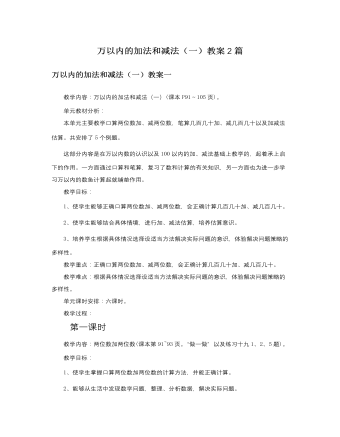
人教版新课标小学数学二年级下册万以内的加法和减法(一)教案2篇
3.小结。引导学生归纳两位数加减法的口算步骤:要把加上或减去的两位数看成一个整十数和一个一位数,先算两位数加、减整十数,再算两位数加减一位数。三、巩固练习课本第93页的做一做。分别指名口算,并说说怎么想的。四、全课总结1.根据学生回答,教师归纳小结并出示课题:口算两位数加、减两位数。2.口算两位数加、减两位数应注意什么?五、布置作业教后反思《标准》提倡算法多样化,目的是提倡学生个性化的学习。本单元仍然注意体现这一理念,如本课时教学口算两位数加、减两位数时,既呈现了口算方法,还出现了在脑中想竖式的方法;在教学笔算时,还出现口算的方法。其目的就是鼓励学生展开思路,在交流、比较的基础上不断地完善自己的想法,学习计算方法。
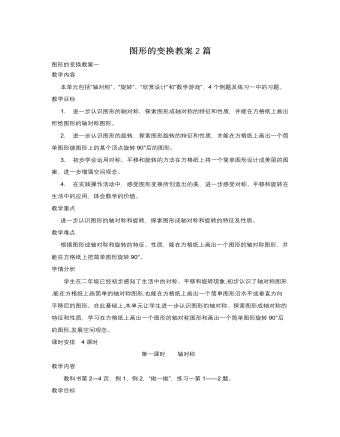
人教版新课标小学数学五年级下册图形的变换教案2篇
师:从图1到图2,风车发生了怎样的变化呢?下面请同学们小组合作,共同来解决报告单上提出的问题。(1)从图1到图2,风车绕点O逆时针旋转了___度。(2)你是怎样判断风车旋转的角度的?生小组讨论。3.小组汇报(实物投影展示)(1)图1到图2,风车绕点O逆时针旋转了90°;(2)组1,根据三角形变换的位置判断风车旋转的角度;(3)组2,根据对应的线段判断风车旋转的角度;(4)组3,根据对应的点判断风车旋转的角度。4.小结(教师边做小结边演示)师:通过观察,我们发现风车旋转后,不仅是每个三角形都绕点O逆时针旋转了90°(闪烁),而且,每条线段(闪烁),每个顶点(闪烁),都绕点O逆时针旋转了90°。5.揭示旋转的特征和性质

人教版新课标小学数学五年级下册分数的意义和性质教案
6. 本题是一道实际应用的题,可以结合生活实际举例,在举例中进一步认识分数。7. (读作八分之一)表示把人的身高看作单位“1”,头部的高度占整个身高的 ; (读作五分之三)表示把整个长江的干流看作单位“1”,受污染的部分占整个长江干流的 ; (读作十分之三)表示把死海表层的水看作单位“1”,含盐量占死海表层水的 。8. 读作六分之一, 读作七分之二, 读作是十五分之四, 读作十八分之十一, 读作一百分之七。它们的分数单位分别是: 、 、 、 、 。9. 本题有两个知识点:一是根据分数的意义涂色,是把12个苹果平均分成了2份,1份有6个苹果; 是把12个苹果平均分成了3份,1份有4个苹果; 是把12个苹果平均分成了4份,1份有3个苹果; 是把12个苹果平均分成了6份,1份有2个苹果; 是把12个苹果平均分成了12份,1份有1个苹果。二是在涂色中感受平均分成的份数越多,每一份越少,也可以说随着分母的增大,几分之一所表示的苹果个数,从 的6个到 的1个,相应地在减少。
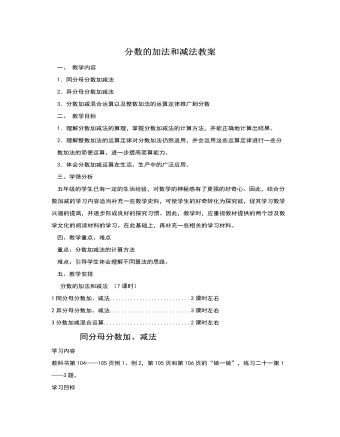
人教版新课标小学数学五年级下册分数的加法和减法教案
二、 教学目标1.理解分数加减法的算理,掌握分数加减法的计算方法,并能正确地计算出结果。2.理解整数加法的运算定律对分数加法仍然适用,并会运用这些运算定律进行一些分数加法的简便运算,进一步提高简算能力。 3.体会分数加减运算在生活、生产中的广泛应用。三、学情分析五年级的学生已有一定的生活经验,对数学的神秘感有了更强的好奇心。因此,结合分数加减的学习内容适当补充一些数学史料,可使学生的好奇转化为探究欲,促其学习数学兴趣的提高,并逐步形成良好的探究习惯。因此,教学时,应重视教材提供的两个涉及数学文化的阅读材料的学习。在此基础上,再补充一些相关的学习材料。四、教学重点、难点重点:分数加减法的计算方法难点:引导学生体会理解不同算法的思路。
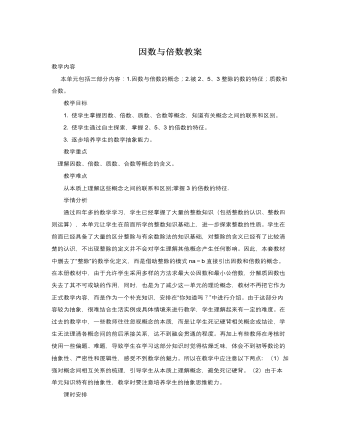
人教版新课标小学数学五年级下册因数与倍数教案
因此,本套教材中删去了“整除”的数学化定义,而是借助整除的模式na=b直接引出因数和倍数的概念。在本册教材中,由于允许学生采用多样的方法求最大公因数和最小公倍数,分解质因数也失去了其不可或缺的作用,同时,也是为了减少这一单元的理论概念,教材不再把它作为正式教学内容,而是作为一个补充知识,安排在“你知道吗?”中进行介绍。由于这部分内容较为抽象,很难结合生活实例或具体情境来进行教学,学生理解起来有一定的难度。在过去的教学中,一些教师往往忽视概念的本质,而是让学生死记硬背相关概念或结论,学生无法理清各概念间的前后承接关系,达不到融会贯通的程度。再加上有些教师在考核时使用一些偏题、难题,导致学生在学习这部分知识时觉得枯燥乏味,体会不到初等数论的抽象性、严密性和逻辑性,感受不到数学的魅力。所以在教学中应注意以下两点: (1)加强对概念间相互关系的梳理,引导学生从本质上理解概念,避免死记硬背。(2)由于本单元知识特有的抽象性,教学时要注意培养学生的抽象思维能力。
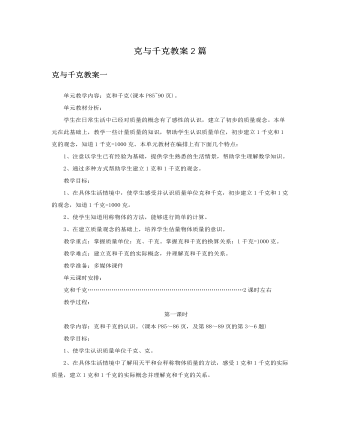
人教版新课标小学数学二年级下册克与千克教案2篇
教学目标1.使学生通过“称一称”的实践活动,亲自感受1克和1千克的实际重量。2.通过实践活动使学生加深质量单位的理解,让学生深刻体会到质量单位与实际生活是紧密联系的,在实际生活中是非常有用的。3.培养学生的动手能力及创新意识。4.培养学生与他人的合作意识和分工合作的精神。重、难点与关键1.进一步了解克和千克的质量单位概念。能够用老师提供的称,来称量物体质量。2.巩固对质量单位实际概念是认识。教具准备天平,盘秤,适量的生活用品,如水果,蔬菜等。教学过程一、创设情境同学们这节课老师带你们去超市逛一逛,想去吗?(出示课本第85页情境图)在超市里你看到了什么?指名回答。(饼干110克、豆油5千克、6个苹果1千克……)这些都表示什么意思呢?指名回答。教师说明表示物品有多重可以用克和千克作单位。那么在日常生活中有什么地方用到克与千克呢?举例说明。
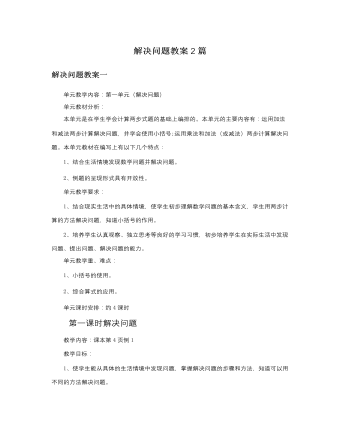
人教版新课标小学数学二年级下册解决问题教案2篇
(1)提问:用自己的话说一说画面的内容。根据画面的内容编一道应用题。可先让学生自由编题,然后出示:面包房一共做了54个面包,第一队小朋友买了8个,第二队小朋友买了22个,现在剩下多少个?(2)全班同学读题后提问:题目的已知条件和问题分别是什么?根据“一共做了54个面包,第一队小朋友买了8个”这两个条件可以求什么?(第一队买后还剩下多少个)怎样列式?【54-8=46(个)】那要求还剩下多少个?又该怎样列式?【46-22=24(个)】谁能列一个综合算式?【54-8-22=24(个)】(列好后,要求学生说出每一步算式的意义)教师:大家想一想还有没有不同的想法?(鼓励学生从不同角度去思考问题)根据“第一队小朋友买了8个,第二队小朋友买了22个”可以求出什么问题?(两队一共买了多少个面包?)可以怎样列式?【8+22=30(个)】那要求还剩下多少个?又该怎样列式?【54-30=24(个)】同桌的同学互相讨论一下:如果写成一个算式,应该怎样列式?
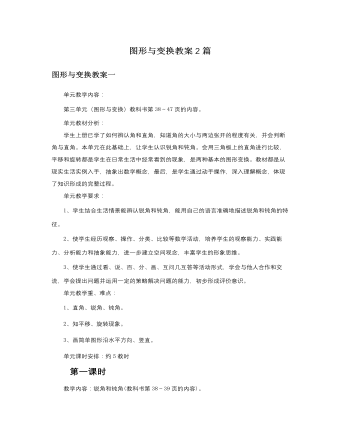
人教版新课标小学数学二年级下册图形与变换教案2篇
第二种分法:分成三类:直角是一类,比直角小的分为一类,比直角的的又分为一类。2.讨论交流,引导学生明确锐角和钝角的意义。教师:比直角小的就是直角的弟弟,比直角的的就是它的哥哥。我们来为它们起个名字好吗?让学生充分交流后引导小结:比直角小的叫锐角,比直角大的叫钝角。相互讨论:怎样判断一个角是不是锐角或钝角?学生讨论(得出和直角比、用眼睛看等方法)三、实践应用,巩固提高1.完成练习九的第1、2题。2.画一画:请你分别画出一个直角、锐角和钝角。四、游戏活动1.折一折,比一比。让学生利用身边的材料折出不同的角,并互相认一认是什么角?2.摸摸、猜猜。(分小组活动)活动规则:把一同学眼睛蒙住,另一同学用活动角掰成大小不同的角,让蒙住眼睛的同学通过手摸后说出是什么角?其他同学当裁判。然后组内同学交换活动。五、全课总结这节课我们学习了什么?你有哪些收获?六、布置作业
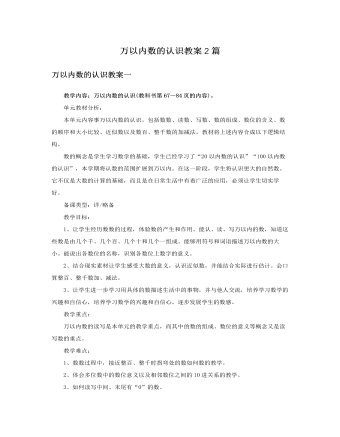
人教版新课标小学数学二年级下册万以内数的认识教案2篇
(3)请同学们在计数器的十位上拨8,百位上拨5。并在自己的课堂本上写出这个数。全班同学读一读这个数。写作:580读作:五百八十教师:个位上没有数,就要用零展位,读的时候不必读出来。提问:这个数是由几个百、几个十和几个一组成。2.练习:完成课本第69页的做一做的第1题。让学生独立完成,然后全班讲评。3.练习:完成课本第69页的做一做的第2题。让学生独立完成,然后全班讲评。小结:今天学习三位数的读法和写法。读、写数都要从高位开始。读数时,一个数百位上是几就读几,十位上是几就读几,个位上是几就读几,数位中间的0就读零,末位的零不读。写数时,一个数有几百就在百位上写几,有几十就在十位上写几,有几个一就在个位上写几,哪一位上一个也没有就那哪一个上写0。三、巩固练习1.完成课本第71页练习十五的第1题。2.完成课本第71页练习十五的第2题。3.完成课本第71页练习十五的第3题。
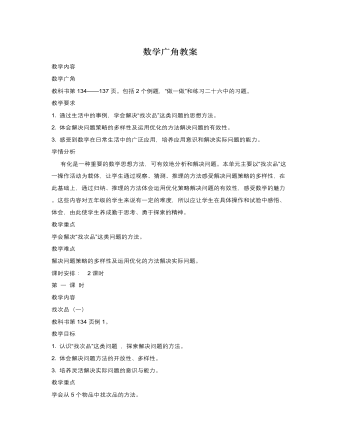
人教版新课标小学数学五年级下册数学广角教案
教学要求1. 通过生活中的事例,学会解决“找次品”这类问题的思想方法。2. 体会解决问题策略的多样性及运用优化的方法解决问题的有效性。3. 感受到数学在日常生活中的广泛应用,培养应用意识和解决实际问题的能力。学情分析有化是一种重要的数学思想方法,可有效地分析和解决问题。本单元主要以“找次品”这一操作活动为载体,让学生通过观察、猜测、推理的方法感受解决问题策略的多样性,在此基础上,通过归纳、推理的方法体会运用优化策略解决问题的有效性,感受数学的魅力。这些内容对五年级的学生来说有一定的难度,所以应让学生在具体操作和试验中感悟、体会,由此使学生养成勤于思考、勇于探索的精神。教学重点学会解决“找次品”这类问题的方法。
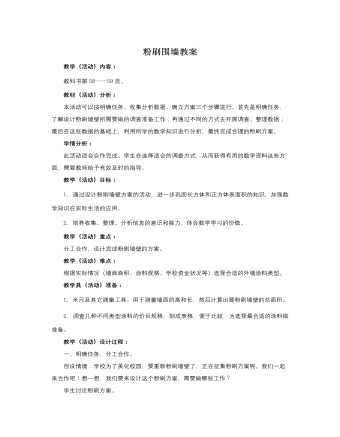
人教版新课标小学数学五年级下册粉刷围墙教案
(3)按每千克涂料粉刷3.5 m2计算,可求出共需要涂料:1600÷3.5≈460(千克);(4)根据涂料的型号及费用,选择合适的涂料。师:选择涂料时,要考虑很多因素,如价格、耐用期、消费心理、环保等,要怎么选择呢?学生可以把几种涂料进行对比,一起讨论决定,同时学会在交流中理解接纳别人较好的建议:如:A型,优点:价格便宜,需要19桶,总共才5700元;缺点:耐用期太短,两年后又要重新粉刷;B-1型和B-2型,虽然桶装量不同,但价格和耐用期都处在中游水平;C型和D型,优点:耐用期长,最划算;缺点:价格太高,不符合人们的消费心理,也不可能持续那么长时间,至少5年就要更换一下样子。综合以上价格、耐用期、消费心理,选择B-1或B-2型比较划算。而这两种比较来看,B-2型更便宜一些,所以,最后确立用B-2型涂料。
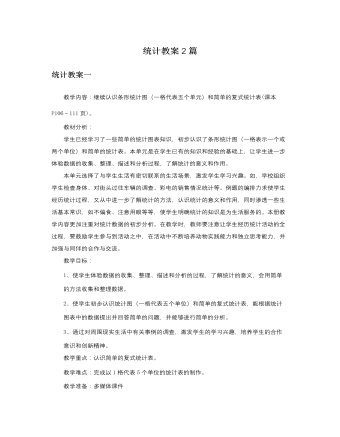
人教版新课标小学数学二年级下册统计教案2篇
2.采用比较简便的方法,师生合作完成“数据的收集与整理(强调数据的准确性),学生独立完成“表格的填写”。3.小组内讨论完成“表格的分析”。4.全班进行反馈。(意在培养独立收集、整理数据的能力,核对数据的准确性,并且扩大提问题的参与面,让学生也能启动智慧、享受快乐;及时反馈信息,调整教学目标)四、全课总结1.通过今天的学习,同学们有哪些收获?2.应用延伸。(课本第112页练习二十二第1题)五、布置作业教后反思统计是日常生产生活中常用和实用的工具,因此统计也是小学生必备的能力之一。但是统计的教学较为枯燥无味,教师往往会轻视统计的教学,忽略学生能力方面的培养。在教学统计时,老师要激发学生学习统计的兴趣,创造各种情景,加强学生统计中的动手实践操作训练,同时在实际生活中加以运用,并逐步加大难度和密度,同时也需要知道,统计教学不要过分地浮夸,多给予学生统计的意义,使其明确学习的目的。
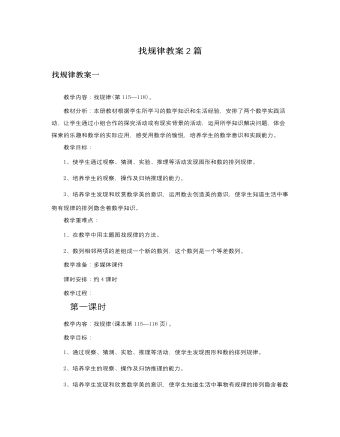
人教版新课标小学数学二年级下册找规律教案2篇
1.动物园里举行运动会,小动物可高兴了,你瞧,他们排着整齐的队伍走出来了。老师分步出示图片,让学生观察,你发现了什么?第一步逐一贴出图片;小熊、兔子、猴子、青蛙;第二步逐一贴出图片:兔子、猴子、青蛙、小熊;第三步逐一贴出图片:猴子、青蛙、小熊、兔子;第四步怎样贴呢,学生试贴:青蛙、小熊、兔子、猴子。教师:为什么这样贴呢?说出你的理由。2.观察整幅方阵图,你们发现了什么?3.请四个学生上台问及此事,做类似方阵图中动物的排列,四位同学不停的变换位置。(体会其中循环排列的含义)教师:深入观察,你们还发现了什么?教师:刚才同学们用自己的语言形容出其中的排列规律;我们可以说这种排列方式是循环排列的规律。4.小东家搞装修,房子是怎样布置的呢?我们一起参观参观,有什么规律呢?学生讨论讲解:墙面与地面都是循环排列的规律。
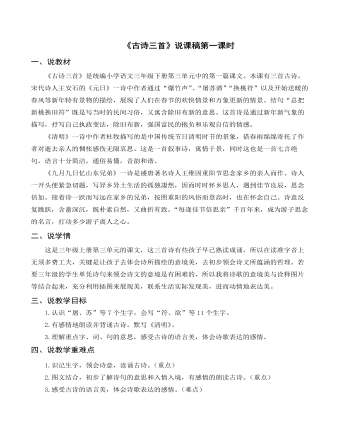
(说课稿)部编人教版三年级下册《古诗三首》第一课时
一、说教材《古诗三首》是统编小学语文三年级下册第三单元中的第一篇课文。本课有三首古诗。宋代诗人王安石的《元日》一诗中作者通过“爆竹声”、“屠苏酒”“换桃符”以及开始送暖的春风等新年特有景物的描绘,展现了人们在春节的欢快情景和万象更新的情景。结句“总把新桃换旧符”既是写当时的民间习俗,又寓含除旧布新的意思。这首诗是通过新年新气象的描写,抒写自己执政变法,除旧布新,强国富民的抱负和乐观自信的情感。《清明》一诗中作者杜牧描写的是中国传统节日清明时节的景象,借春雨绵绵寄托了作者对逝去亲人的惆怅感伤无限哀思。这是一首叙事诗,寓情于景,同时这也是一首七言绝句,语言十分简洁,通俗易懂,音韵和谐。

部编人教版六年级下册《十六年前的回忆》说课稿(一)
一、说教材《十六年前的回忆》是统编语文小学六年级下册第四单元中的一篇精读课文。本课的作者是李星华,通过对李大钊被捕前到被捕后的回忆,展示了革命先烈忠于革命事业的伟大精神和面对敌人坚贞不屈的高贵品质,表达了作者对父亲的敬仰与深切的怀念。除开头外,文章是按被捕前、被捕时、法庭上、被害后的顺序来叙述的。被捕前写父亲烧掉文件和书籍,工友阎振三被抓,反映出形势的险恶与处境的危险;被捕时写了敌人的心虚、残暴与父亲的处变不惊;法庭上描写了李大钊的镇定、沉着;被害后写了全家的无比沉痛。 本文是回忆录。作者采用第一人称的叙述方式,回忆了父亲被害的全过程,内容真实可信,语言朴素自然,既具有文学价值,又具有很强的史料价值。选编这篇课文的主要意图,一是使学生借助课文,激发对革命先烈的崇敬之情;二是引导学生领悟课文前后照应的写法。

部编人教版四年级下册《 “诺曼底号”遇难记》精彩片段(一)说课稿
师:请同学们思考一个问题?面对这猝然而至的灾难,甚至可以说是死亡,一边是惊慌失措,一边是镇定自若,为什么独有哈尔威船长能够做到镇定自若?生:因为他是船长。师:是船长就一定能镇定自若吗??生:(思考后)他不仅是个船长,而且是个忠于职守的好船长。师:每个人都有自己的工作岗位,也都有自己的岗位职责,譬如说:教师的岗位职责就是教书育人。那么,哈尔威船长的职责是什么呢?生:我觉得,作为一名船长,他最大的职责就是开好船,保证乘客的生命安全。?师:你觉得他尽到自己的职责了吗?
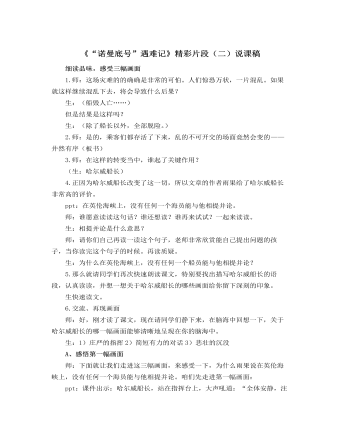
部编人教版四年级下册《 “诺曼底号”遇难记》精彩片段(二)说课稿
师:对,镇定自若。(板书:镇定自若)这份镇定自若,别人能与他相提并论吗?(不能)4.你还能从这段话中读出什么来?妇女先走,船员断后。咱们常说女士优先,在灾难面前也做到让妇女先走,这叫什么?生:绅士风度。(板书:绅士风度)5.同学们,假如你就是哈尔威船长,面对混乱的人群,你准备怎样来下达这道命令?指名学生朗读。(师指导:场面混乱,情况危急。)师:在灾难面前,时间就是生命。师:这是庄严的指挥,这是威严的指挥。我们一起来读读。师:真好,读得好,脸部的表情也非常到位,满脸的威严,正因为这样,所以课文的作者雨果是这样评价船长的,再读。ppt:在英伦海峡上,没有任何一个海员能与他相提并论。(生齐读)师:不能与他相提并论的还有他的:忠于职守、镇定自若、绅士风度。这是咱们从第一幅画面中感受到的。

部编人教版六年级下册《骑鹅旅行记(节选)》说课稿(二)
一、说教材《骑鹅旅行记》是拉格洛芙为儿童写的唯一一部长篇童话。它是根据瑞典教育部的要求,作为学校的地理教育读物而写的,不料后来却成为了世界文学艺术中的珍品。因为拉格洛芙的巨大成就,1914年她被选为瑞典皇家学会会员。在瑞典,现在有一项最重要的儿童文学奖,就是用“尼尔斯”这个名字命名的。《尼尔斯骑鹅旅行记》写了一个不爱学习、喜欢恶作剧的顽皮小男孩尼尔斯历险的故事。一天,尼尔斯因为捉弄了一个小精灵而被小精灵用妖法变成一个拇指大的小人儿,后来,他骑在他家的大白鹅背上跟着一群大雁走南闯北,周游各地,一路上,他增长了许多见识,结识了许多朋友,听了许多故事传说,也经历了无数的危险。在漫长的旅途中,尼尔斯逐渐成长起来,懂得了什么是善恶,学会了同情和爱……
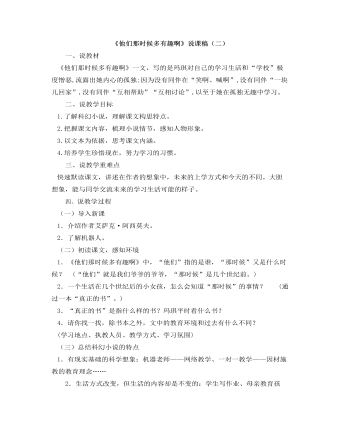
部编人教版六年级下册《他们那时候多有趣啊》说课稿(二)
一、说教材《他们那时候多有趣啊》一文,写的是玛琪对自己的学习生活和“学校”极度憎恶,流露出她内心的孤独;因为没有同伴在“笑啊、喊啊”,没有同伴“一块儿回家”,没有同伴“互相帮助”“互相讨论”,以至于她在孤独无趣中学习。 二、说教学目标1.了解科幻小说,理解课文构思特点。2.把握课文内容,梳理小说情节,感知人物形象。3.以文本为依据,思考课文内涵。4.培养学生珍惜现在,努力学习的习惯。 三、说教学重难点快速默读课文,讲述在作者的想象中,未来的上学方式和今天的不同。大胆想象,能与同学交流未来的学习生活可能的样子。 四、说教学过程(一)导入新课1.介绍作者艾萨克·阿西莫夫。2.了解机器人。(二)初读课文,感知环境1.《他们那时候多有趣啊》中,“他们”指的是谁,“那时候”又是什么时候? (“他们”就是我们爷爷的爷爷,“那时候”是几个世纪前。)





















